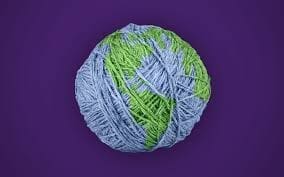Indigenous design is rooted in sustainability. Whether it’s contemporary or traditional works, Indigenous artists in North America today approach their creation process in the same way that their ancestors did: with a mutual respect for nature and the world that they live in. As a result, their pieces are innately eco-minded; the community takes a unified approach toward using locally sourced hides and textiles, creating small made-to-order collections, and repurposing scraps or older items into brand new pieces. Take Indigenous-owned lines such as Orenda Tribe, which repurposes vintage pieces, or Ginew, a unisex denim like that makes use of a raw, selvedge materials in small quantities.
In short, it’s everything that fast fashion is not. But sustainability is a major topic of conversation in the fashion industry right now. From smaller independent designers to mega retailers like H&M, many brands are attempting to do their part by figuring out a way to be kinder to the environment and to the people who make our clothes. It’s a movement that has pressing momentum behind it. A recent U.N. report said a global climate crisis could occur by 2040 if emissions aren’t reduced soon, and we don’t quite know how much fashion is contributing to that (two estimates say between eight and 10 percent, but those figures have been called into question). What is clear is that fashion production wastes a lot of materials, pollutes water and air, and leaves many workers across the supply chain supremely vulnerable. And after all that, clothes often end up in a landfill.
Yet, there is one place in the fashion industry where reducing waste has always been designers’ mandates—and these Indigenous artists have ideas on what needs to be done to further tackle climate change, labor abuses, and waste as they relate to the fashion industry. “[Being sustainable] was our lifestyle for survival. You never over-harvested or -hunted, and what you did take, you would use every bit to honor the earth and life you took,” artist Jamie Okuma says. “To truly be sustainable, you have to be small and produce less, which no business wants to hear, and I get it.” Being sustainable will soon be crucial to all industries, and it’s clear the mainstream fashion industry has a lot to learn.
With that in mind, Vogue asked 15 Indigenous designers to weigh in on sustainability in fashion. From the valuable lessons they were taught growing up to what they think the future of the industry might hold, read on to hear from those already innovating eco-minded initiatives.
Molina Parker (Oglala Sioux), artist
“Pre-colonization, natives used every scrap of material they had, which was usually animal skins. Natives today still follow that concept. My mother would make most of my clothes when I was a young girl, and often her and I would match because she would use every scrap of fabric she had to make as many things as she could. From one cut of fabric, I’d have a jumper, her a shirt, and the rest would go in a scrap pile for quilts and doll clothing.
The fast fashion industry isn’t doing enough to maintain safe working conditions or waste disposal. The initiatives in place are not doing enough to penalize the brands that are killing the planet. The only way this culture will change is if the consumer changes their shopping habits. My hope for the future would be for people to take a step back and appreciate what they already have. Learn to sew their own clothes, buy from small, sustainable companies and individuals that are practicing safe working environments, and leaving smaller carbon footprints.”
Tania Larsson (Gwich’in), jeweler
“[In my culture] we are taught you should never take more than you need, as it can affect the natural balance and have dire consequences for your whole community. My Indigenous values are the pillars of my business model: I know my supply chain, I can tell you where the materials for my jewelry was harvested, provided by what hunter, tanned and sewn with the help of which person. Same for my beads: I only use deadstock, vintage, and antique beads. The current fashion industry is extremely wasteful: There are too many collections in a year. As creators and consumers, it is time to demand change.”
Dusty LeGrande (Nehiyaw/Woodland Cree), owner, Mobilize
“As Indigenous communities, we have always lived in balance with Mother Earth. We have had to sustain our techniques, and culture through stories and designs; this continues today. The industry is beginning to move in the right direction: The corporate nature of fashion must be flushed out to honor the communities we exist in, and to promote local sustainability. The next step we must all make is finding ways to recycle, reuse, and reimagine fabric. I’m very fond of reusing and repurposing vintage clothing, taking a piece that already exists and bringing it fresh new life.”

